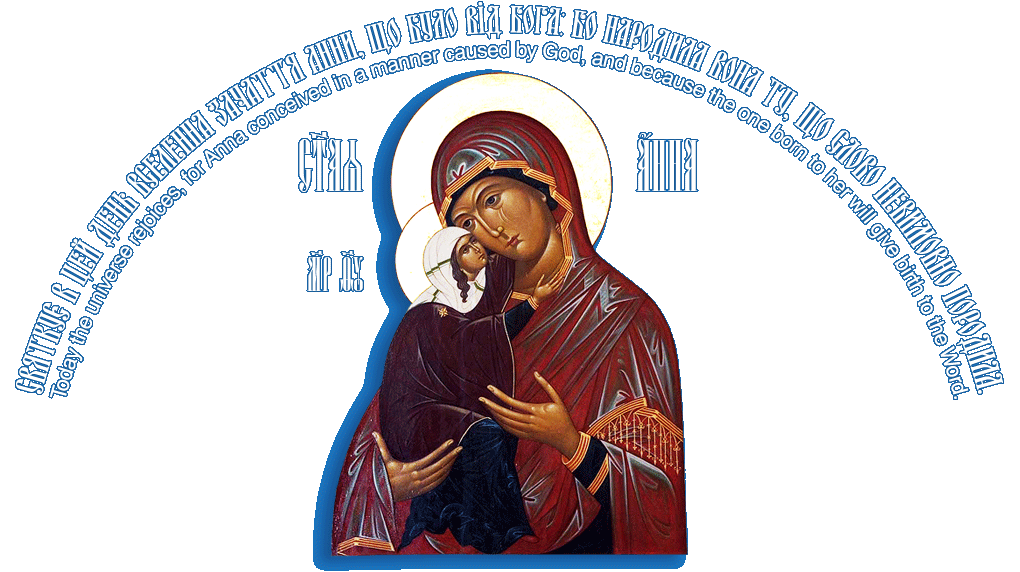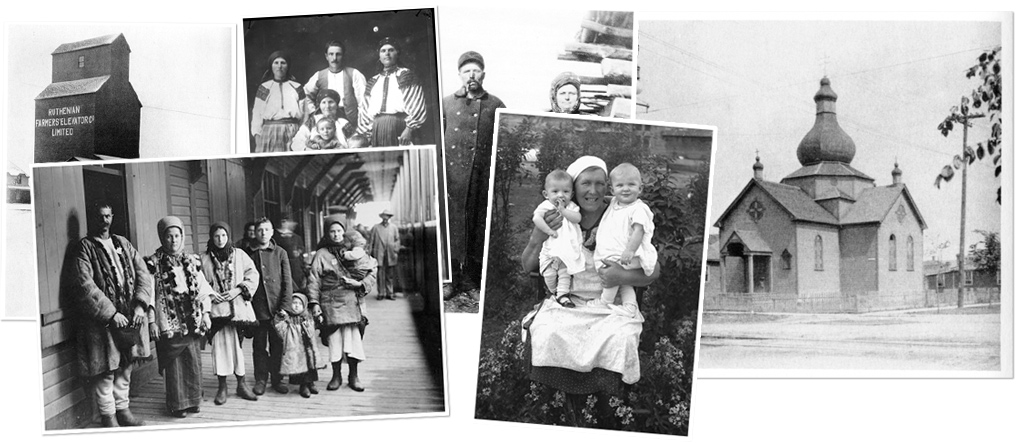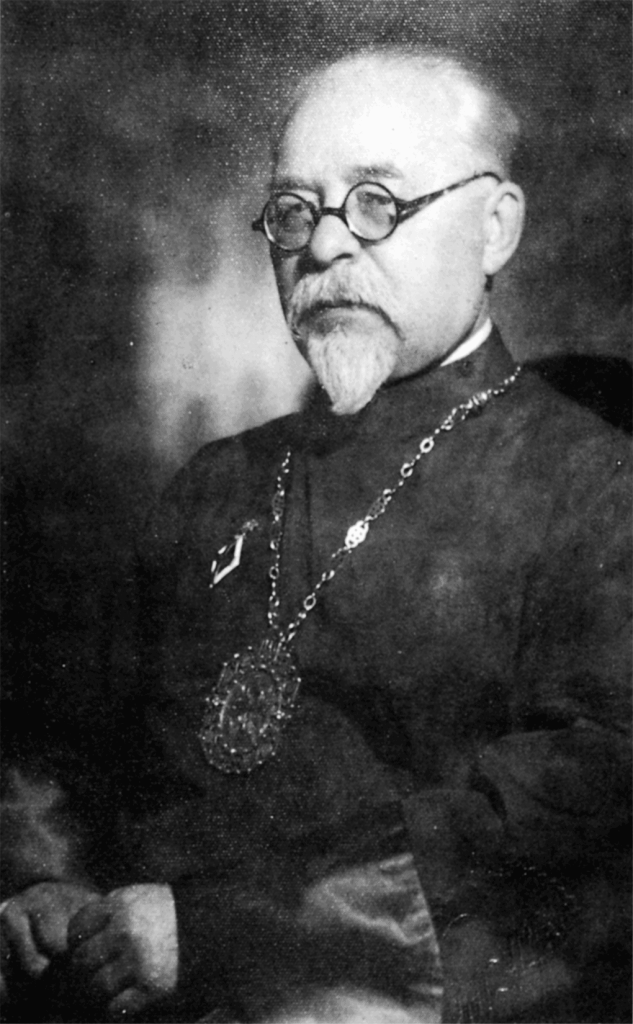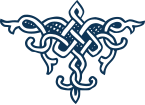The Ukrainian Orthodox Church of Canada Українська Православна Церква в Канаді
Ezra 5:8-11
Be it known unto the king, that we went into the province of Judea, to the house of the great God, which is built with great stones, and timber is laid in the walls, and this work goes on diligently, and prospers in their hands.
Then asked we those elders, and said unto them, Who commanded you to build this house, and to complete these walls?
We asked their names also, to inform you, that we might write the names of the men that were the chief of them.
And thus they returned us answer, saying, We are the servants of the God of heaven and earth, and build the house that was built these many years ago, which a great king of Israel built and finished.
Ездра 5:8-11
Щоб було відоме цареві, що ми ходили до Юдейської округи, до дому великого Бога, а він будується з великого каменя, і дерево кладеться в стіни. А робота та робиться докладно, і успіх у їхній руці.
Тоді ми питалися тих старших, і сказали їм так: Хто видав вам наказа будувати цей храм і кінчати цю святиню?
А також питалися ми їх про їхні імена, щоб повідомити тебе, що запишемо ім’я тих мужів, які за голову в них.
А вони так відповіли нам та сказали: Ми то раби Бога небес та землі, і будуємо храма, що був збудований за багато літ перед цим, а збудував його й докінчив його великий Ізраїлів цар.
The Ukrainian Orthodox Church of St. Anne in Scarborough, Ontario, is a parish of the Ukrainian Orthodox Church of Canada, under the stewardship of His Eminence, Metropolitan YURIJ (Kalistchuk), Archbishop of Winnipeg and the Central Eparchy. The Church in Canada is rooted in the bittersweet history of European upheaval and opportunity abroad that has marked much of the Ukrainian immigrant experience. In 2019, the Church celebrates its first 100 years of worshipping God the Father, Son and Holy Spirit.
The seeds of the Orthodox Faith were sown on Canadian soil not solely by missionaries, but by the people — farmers, miners, working men and women, business owners, intellectuals — who came from Ukraine and established themselves in a new land of hope and promise. It is on their, at times simple, yet devout faith and indomitable pioneering spirit that the Ukrainian Orthodox Church of Canada was built.
Most of the first Ukrainian settlers came to Canada from Galicia/Галичина (largely, Greek Catholic) and from Bukovyna/Буковина (mainly Orthodox). Given the size and the scattered population of the Canadian prairie, Galician immigrants settling in Canada where visited infrequently by Greek-Catholic priests — and the Roman-Catholic hierarchy, both in Canada and at the Vatican, resisted calls to permit the organization of an Eastern Rite “Ruthenian” Church on Canadian soil. Bukovynians arriving in North America usually incorporated themselves into the Russian Orthodox Mission already in existence. Despite this, immigrants from Ukraine desired to have a Church which would be closer to the spiritual and cultural needs of their own people, and this led to the formation of the Ukrainian Greek Orthodox Church of Canada (later, Ukrainian Orthodox Church of Canada or UOCC).
In July, 1918, a confidential conference of disenchanted lay Eastern Rite Catholics from Manitoba, Saskatchewan and Alberta created an Orthodox Brotherhood (a «Братсво»). Its goal was to organize the Ukrainian Greek Orthodox Church of Canada. Although the Ukrainian settlers who took part in the organization of this body were not theologians, they were conscious of Canon Law and the principles of Apostolic Succession — and understood that a Church cannot exist without a bishop. The brotherhood therefore contacted Archbishop ALEXANDER (Nemelovsky), a Ukrainian in the Russian Orthodox Mission in North America, who initially agreed to lead the Church as its temporary bishop and to preside at its first Sobor — but later, under political pressure from Russia, refused. The first “Sobor” took place anyway on December 28, 1918, without the presence of a bishop, and led to the establishment of the first seminary in Saskatoon. The second Sobor was held on November 27, 1919, with the presence of the Antiochian Metropolitan GERMANOS (Shahedi), who accepted the leadership of the Church until the time it would have its own bishop. The fledgling Church was under the canonical jurisdiction of the Patriarch of Antioch for five years, until 1924.
The new Church was a distinctly Canadian institution, not a branch of any based in Ukraine. It accepted the dogma, rites and practices of Eastern Orthodoxy. It also stressed that the Church was to be conciliar in organization — giving lay delegates a voice and a vote in administrative matters at the Church’s General Councils and on the main administrative body of the Church, the Consistory. The Consistory is composed of the Synod of Bishops, nine clergy and nine members of the laity. The Metropolitan and his Synod of Bishops retain exclusive authority in all matters of Orthodox belief and practice.
In 1924, an Archbishop of the Ukrainian Autocephalous Orthodox Church, Archbishop JOHN (Theodorovich) arrived in the United States to lead the Ukrainian Orthodox Church in America. Influenced by the presence of a Ukrainian bishop on the North American continent, the fourth Sobor of the Ukrainian Greek Orthodox Church of Canada — held on July 16-17, 1924 — decided to invite him to become its ruling bishop. He accepted, and began visiting Canada during the summers. In his absence during the winters, administrative functions were carried out by the priest-administrator at the Office of the Consistory — Father Semen Sawchuk.
The Ukrainian Self-Reliance League, formed in 1927, became an effective lay arm for the Church, and bolstered its material resources. By the end of 1928 the Ukrainian Greek Orthodox Church of Canada had approximately 64,000 followers, organized in 152 communities, served by 21 priests. It was strongest in Saskatchewan (with 81 congregations in 1940), Alberta (with 55 congregations), and Manitoba (53 congregations). In 1946, the Church opened a theological school — St. Andrew’s College, in Winnipeg.
In 1951, following a period of leadership controversy, an extraordinary Sobor was called. The Consistory had found four candidates for the office of local ruling bishop. They were all canonically elected and ordained by the Holy Synod of the Warsaw Metropolitanate (Autocephalous Orthodox Church in Poland). Of these candidates, three came to Canada:
- the Metropolitan of Kholm and Pidliasha ILARION (Ohienko), who came to Canada in 1947 at the invitation of St. Mary the Protectress Cathedral (Sobor) in Winnipeg;
- Archbishop MICAHEL (Khoroshy), who came to Canada in 1951 at the invitation of the Consistory;
- and Bishop PLATON (Artemiuk) who came to Canada in 1951 with the blessing of Metropolitan Polikarp (Sikorsky), but who prematurely fell asleep in the Lord.
The extraordinary Sobor decided to follow the canonical system of a Metropolia to administer the Ukrainian Orthodox Church of Canada, creating a Metropolia with three eparchies. Metropolitan Ilarion (Ohienko) was chosen Metropolitan of Winnipeg and all Canada, and Archbishop MICHAEL (Khoroshy) became Archbishop of the Eastern Eparchy. The period of Metropolitan ILARION’s archpastoral work in Canada was marked by academic and ecclesiastical initiative.
By 1951 the Ukrainian Greek Orthodox Church of Canada had almost 300 congregations, 70 priests, and some 110,000 adherents. This growing Metropolia felt the need for new bishops. In the next 12 years, two Archmandrites were elevated to the rank of bishop: Bishop Andrew (Metiuk) of Edmonton and the Western Eparchy in 1959; and Bishop Boris (Yakovkevych) of Saskatoon and auxiliary of the Central Eparchy, in 1963.
After twenty-one years of zealous archpastoral ministry, Metropolitan Ilarion fell alseep in the Lord on March 29, 1972. His passing was felt as a great loss. Archbishop Michael was chosen to replace him, and he was at the head of the Metropolitanate until 1975. Archbishop ANDREW succeeded him, and remained the Metropolitan for ten years, until his blessed repose on February 2, 1985. During the time of his administration new bishops were ordained: Bishop Nicholas (Debryn) in 1975, Bishop WASYLY (Fedak) on July 16, 1978, and Bishop JOHN (Stinka) on November 27, 1983.
After the death of Metropolitan ANDREW in 1985, Bishop WASYLY became the Church’s primate. During his term, Archmandrite Yurij (Kalistchuk) was elevated to Bishop YURIJ of Saskatoon on October 22, 1989.
Historically, UOCC membership has been relatively stable, and has ranged between 20 and 25 percent of the total Ukrainian Canadian population. By 1989, the Church’s estimated membership was 128,000 in 290 congregations with 99 clergy.
Fulfilling the desires and intentions of the ever-memorable his predecessor, Metropolitan Ilarion, Metropolitan Wasyly — assisted by the Consistory and with the help of God — concluded the canonical ordering of the Ukrainian Orthodox Church of Canada.
After visits and discussions with the Ecumenical Patriarchate, the Ukrainian Orthodox Church of Canada was received into the Ecumenical Patriarchate in 1990, at the time of His Holiness, the Ecumenical Patriarch Dimitrios, normalizing its relations with the other Orthodox Churches. This made it a duly recognized member of the Orthodox family which consists of four ancient Patriarchates (Constantinople, Jerusalem, Alexandria and Antioch) and over a dozen other autocephalous (self-headed) and autonomous Churches, some also headed by Patriarchs. The Primates of these Churches manifest their unity by commemorating each other during Liturgy and Divine Liturgy together on special solemn occasions.
According to the Patriarchal Decree, upon entering the Ecumenical Patriarchate the Ukrainian Orthodox Church of Canada remains a Metropolitanate with full internal autonomy, having as its canonical head the Ecumenical Patriarch to whom it has canonical reference in all things. This status recalls the days, when the Kyivan Metropolitanate was an Exarchate of the Ecumenical Patriarchate, and when there were very close Church relations between Constantinople and Kyiv, for the good of these two important Church centers.
The quintennial Councils (Собори) are the highest decision-making bodies of the Ukrainian Orthodox Church of Canada. Executive duties are shared between the Council of Bishops and the Consistory based in Winnipeg, with elected clerical and lay representatives from each diocese. The Ukrainian Self-Reliance League, with its component organizations, continues to play a significant role in Church affairs at the local and national levels.
In addition to St. Andrew’s College and its Faculty of Theology, the Church is affiliated with a number of student residences and cultural centres: the Mohyla Ukrainian Institute in Saskatoon, St. John’s Institute in Edmonton, and St. Vladimir Institute in Toronto. Its official publication since 1924 has been «Вісник» | “The Herald”.
The Ukrainian Orthodox Church of Canada is an important religious element in Canada, where Ukrainian culture and heritage are fused with the Orthodox Christian faith to form a living and vibrant tradition.
Based on information by Rt. Rev. Protopresbyter Dr. Oleh Krawchenko, Hierdeacon Job Getcha, Dr. Oleh Gerus, and on Consistory records.



